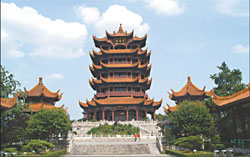Background
Wuhan
Updated: 2010-06-19 16:59
 |
Large Medium Small |
Wuhan,the capital of Central China's Hubei Province, covers an area of 8,494 square kilometers. It has a population of 8.19 million and has 13 administrative districts.
The city's downtown area comprises three towns Wuchang, Hankou and Hanyang which are separated by the Yangtze River and the Hanjiang River.
|
|
|
Firstly built in AD 223, the Yellow Crane Tower is the landmark and trademark of Wuhan. |
Wuhan is a city with a long history spanning 3,500 years.
The city is a well-known tourist destination, with attractions like the Yellow Crane Tower, Guqin Stage, Donghu Lake, and Guiyuan Temple.
It is situated at the center of the nation, about 1,000 kilometers away from the country's major cities such as Beijing, Shanghai, Guangzhou, Chongqing and Hong Kong.
Wuhan plays an important role in transportation.
It is connected to the rest of the country by the Yangtze River, the Beijing-Guangzhou Railway, the Beijing-Zhuhai Expressway and the Shanghai-Chengdu Expressway.
The Tianhe International Airport, the largest airport in Central China, provides convenience for investors from home and abroad.
The city is one of the nation's important centers of finance and commerce. A large number of regional headquarters of domestic and overseas enterprises and nine foreign financial organizations are established in Wuhan.
The city has a solid industrial foundation, with strong capabilities in a variety of industries including iron and steel, vehicles and shipbuilding.
The city's iron and steel industry, represented by the Wuhan Iron and Steel (Group) Corporation, is No 3 in China in terms of overall production capacity.
And the Wuhan Economic and Technological Development Zone is one of the nation's three largest production bases for vehicles.
In addition, 52 institutions of higher learning have been set up in Wuhan, with 747,200 students. There are also 105 research institutions with 61,000 staff members.
Wuhan is also home to 14 State-level laboratories and 13 State-level technological research centers. And the city is one of the first national research and development bases for high-tech innovation.
Wuhan is rich in water resources, including 147 lakes and many rivers covering 25.6 percent of the city's land area the top coverage rate of the nation's big cities. And the surface water per capita amounts to 114,000 cubic meters, the largest volume compared to the world's other big cities.
